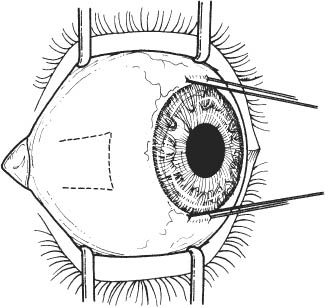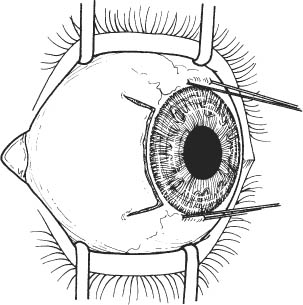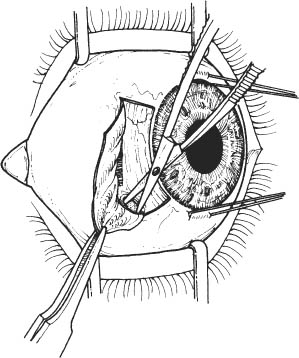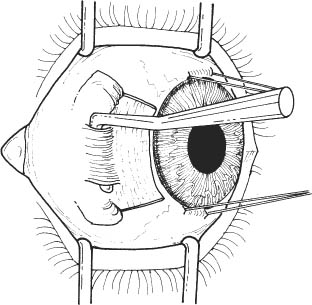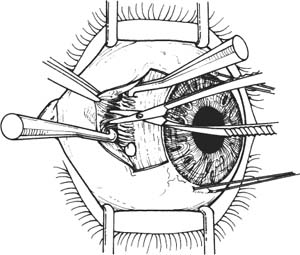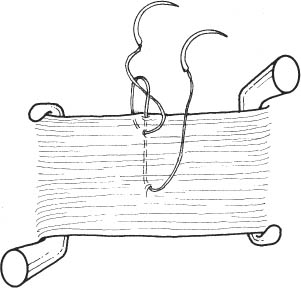38 Extraocular muscle imbalance requiring muscle strengthening for correction (e.g., lateral rectus resection in esotropia). See Chapter 3. A complete strabismus evaluation with the determination of the detailed surgical plan is necessary. Note: Figures are drawn from the surgeon’s viewpoint with the surgeon standing at the head of the patient. 1. Anesthesia: General anesthesia or retrobulbar/peribulbar injection plus lid block. 2. Place a drop of neosynephrine 2.5% into the eye to constrict the blood vessels and decrease bleeding. Prep and drape. 3. Place lid speculum. 4. Place a 6–0 silk episcleral stay suture at the limbus at 6 and 12 o’clock. Optional: May use locking Castroviejo forceps instead of stay sutures. Figure 38.1 5. Secure globe with stay sutures to expose surgical field (see Fig. 38.1). Figure 38.2 6. Prepare a fornix-based winged limbal peritomy down to bare sclera with Westcott scissors (see Fig. 38.2). Figure 38.3 7. Buttonhole the Tenon capsule and intermuscular septum with sharp and blunt dissection with Westcott scissors to reach bare sclera on either side of the muscle insertion (see Fig. 38.3). a. Aim 45 degrees between the horizontal and vertical recti to avoid injuring the muscles. b. Bluntly spread the incision with Westcott scissors. c. Repeat on the opposite side of muscle insertion. 8. Isolate the muscle (see Fig. 38.4). a. First sweep the Stevens tenotomy hook through the fascial buttonhole and under the muscle. Hold hook parallel to and flush with bare sclera to facilitate passage. Figure 38.4 b. Follow with a Green muscle hook perpendicular to the sclera and just posterior to the Stevens hook. Keep the tip of the Green hook pressed against the sclera. c. Remove the Stevens tenotomy hook. d. Follow with a second Green muscle hook perpendicular to the sclera and just posterior to the first Green hook. Once again, keep the tip of the Green hook pressed against the sclera. e. Remove the first Green hook. f. The tip of the muscle hook can be visualized on the other side of the muscle. If not, repeat steps 8d–e. Figure 38.5 9. Tent the overlying conjunctiva with Stevens tenotomy hook and use Westcott scissors to carefully cut the check ligaments to the muscle sheath. Take care not to cut the muscle sheath or the muscle as bleeding may occur. If bleeding occurs, apply direct pressure with a dental roll or cellulose sponge until it stops (see Fig. 38.5). Figure 38.6 10. Incise the intermuscular septum superior and inferior to the muscle to obtain adequate muscle exposure. Be careful not to cut the inferior oblique muscle if incising along the inferior border of the lateral rectus. 11. Place the second Green hook under the muscle and expose the muscle (Fig. 38.6). Figure 38.7 12. Suture the muscle with two double-armed 6–0 Vicryl sutures (Fig. 38.7). a. Measure the length of resection with the calipers. Do not stretch the muscle while measuring. b. The first throw of the first suture is placed at the measured site from the center of the muscle to the superior edge through half-thickness muscle. The second throw is through full-thickness muscle starting from underneath the muscle, 2 mm from the edge of the muscle. Lock the second throw.
Horizontal Rectus Resection
Indications
Preoperative Procedure
Instrumentation
 Lid speculum (e.g., Lancaster, Barraquer)
Lid speculum (e.g., Lancaster, Barraquer)
 Needle holder
Needle holder
 Sutures (6–0 silk with spatula needle, double-armed 6–0 Vicryl with spatula needle (S29 or S14), 7–0 Vicryl suture)
Sutures (6–0 silk with spatula needle, double-armed 6–0 Vicryl with spatula needle (S29 or S14), 7–0 Vicryl suture)
 Toothed forceps (e.g., Bishop-Harmon, 0.5 mm Castro-viejo)
Toothed forceps (e.g., Bishop-Harmon, 0.5 mm Castro-viejo)
 Two locking 0.5 mm toothed forceps
Two locking 0.5 mm toothed forceps
 Westcott scissors (rounded tips)
Westcott scissors (rounded tips)
 Cautery (bipolar forceps)
Cautery (bipolar forceps)
 Muscle hooks (e.g., Green, Jameson)
Muscle hooks (e.g., Green, Jameson)
 Stevens tenotomy hooks
Stevens tenotomy hooks
 Castroviejo caliper
Castroviejo caliper
 Muscle clamp (e.g., Apt or Jameson) or Hartman mosquito hemostat
Muscle clamp (e.g., Apt or Jameson) or Hartman mosquito hemostat
 Scalpel with #15 blade
Scalpel with #15 blade
Operative Procedure
Limbal Approach
Stay updated, free articles. Join our Telegram channel

Full access? Get Clinical Tree


